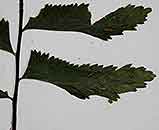Asplenium unilaterale Lam.
Synonyms |
Asplenium resectum Sm. |
|---|---|
Common name |
|
Description |
Rhizome creeping, c.3 mm thick; rhizome scales 2-3 mm long, dark brown, lanceolate, margins entire. Fronds spaced apart, erect, herbaceous. Stipe 7.5-22 cm long, stipe and rhachis glabrous, dark brown to almost black. Lamina 17-30 × 5-10 cm, pinnate, narrowly elliptic to oblong in outline, lowest pinnae hardly reduced but often more lobed, apex decrescent and tapering to a point. Pinnae 12-20 pairs, glabrous, narrowly triangular-rhombic or shaped like a parallelogram, up to 3.5-6 x 0.5-1.2 cm, upper margin toothed to lobed, costa forming the lower margin for about 1/2 to 3/4 of the pinna length. Sori 2-10(-14), oval-linear, set along the veins towards the apex of the pinnae, 2.5-3 mm long; indusium narrowly oblong, membranous, entire, 0.8 mm wide. |
Notes | This taxa is easily recognisable by the costa forming the lower edge of the pinna for 1/2 to 3/4 of its length. and differs from A. obscurum by having a dark brown to almost black stipe and smaller sori (± 3 mm long) that are sparsely scattered towards the pinna apex. |
Derivation | unilaterale: one-sided, referring to the form of the pinnae. |
Habitat | Moist evergreen or riverine forest, deeply shaded stream banks or near waterfalls. |
Distribution worldwide | Africa, Mascarene Isl., Pacific Isl., S and E Asia. |
Distribution in Africa |
Angola, Cameroon, Central African Republic, Congo, Equatorial Guinea (incl. Bioko), Ethiopia, Ghana, Guinea, Ivory Coast, Kenya, Liberia, Malawi, Niger, Nigeria, Sierra Leone, Sudan and South Sudan, Swaziland, Tanzania , Uganda, Zimbabwe. |
Growth form |
Lithophytic, terrestrial. |
Literature |
|

